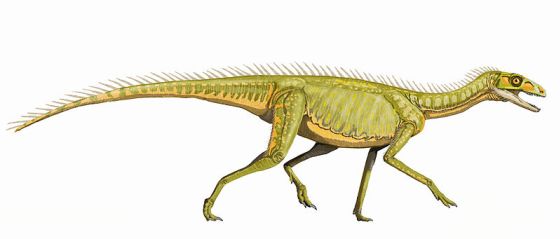Another clue to the origins of dinosaurs
This was originally posted at: http://blogs.egu.eu/palaeoblog/?p=1222
Often the early evolution and radiation of the first dinosaurs is an overlooked part of their tale, in favour of the more dramatic but arguably no less important tales of their later radiations and extinctions. It is actually a fairly poorly understood part of their evolution too, with the timing, and actual mechanism that drove them to become the most successful land group ever still a bit of a mystery.
We are, however, learning more and more about this important phase of their history, in a time known as the Late Triassic some 231-201 million years ago. A new fossil site from this time in Poland – probably not one of the places you’d associate with important fossils – is helping to fill in the blanks. Usually, dinosaur-bearing sites from around this time are known from the southwestern United States and southern South America, so a European locality can potentially tell us quite a bit!
So what is present in this new site? One animal is known as a silesaurid – a weird reptile from a group of dinosaur ancestors called a dinosauriform, known just from a thigh bone. Another is probably one of the most ancestral theropod dinosaurs, typically known from South America, called a herrerasaurid – however, there’s still quite a bit of debate about what position these guys occupied around the origin of dinosaurs. Another specimen is a definite theropod dinosaur, known from parts of the hip bones, as well as a neotheropod (a dinosaur that could bend the Matrix to it’s will – ha. ha.), known from a portion of the tibia – one of the lower leg bones.

So it’s rather an eclectic collection of not easily identifiable to the species level, but important specimen in refining the origins of important groups of early dinosaurs and dinosaur relatives. Such an association of animals is known from North America, the famous Chinle Formation, suggesting that this ecological grouping was fairly common through the Late Triassic. Additionally, it suggests that there was little latitudinal control on this distribution, with the Chinle Formation being about 10 degrees North, and the Polish locality being around 35-40 degrees North at this time. We also now know that dinosaurs were occupying the top apex predator parts of food webs now by this point, perhaps a quite important role in their early success.
So while these fossils aren’t particularly spectacular, or representing some grand new tyrannosaur species or anything, they are scientifically important in providing an extra clue in the still ongoing mystery of dinosaur origins. As an ongoing study, new fossil finds from the Polish site should continue to provide exciting insight into the story of the early evolution of the most successful land animals ever.
Reference:
Niedzwiedski et al., (2014) Basal dinosauriform and theropod dinosaurs from the Mid-Late Norian (Late Triassic) of Poland: implications for dinosaur evolution and distribution, Palaeontology (link)